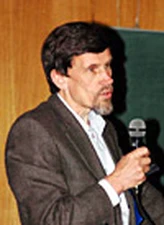Victor A. Sergeev

The 2008 Julius Bartels Medal is awarded to Victor A. Sergeev for his unique and outstanding contributions towards understanding the physics of current sheets and their role in magnetospheric dynamics.
Professor Victor Sergeev has played a pivotal role in developing our understanding of how the magnetotail current sheet works and how its processes influence the large-scale magnetospheric dynamics. He recognized early on that the plasma sheet flows are far from laminar and are concentrated in localized bursts. Even though his term impulsive dissipation events of such small-scale bursts did not make its way to common terminology, his ideas are employed in a variety of recent models and phenomenological scenarios of magnetospheric substorms. His recent results from the ESA Cluster mission have further highlighted the small-scale structuring of the current sheet and the importance of these processes to the large-scale dynamics. He also provided the original concept of how steady convection might be sustained in the magnetosphere without breaking the pressure balance in the inner magnetosphere.
Sergeev’s success stems from his seminal interest and experience in using a wide variety of both ground-based and space-borne instrumentation to study space plasma processes. Already in his early works he interprets ionospheric flows and auroral signatures in terms of plasma motions in the high-altitude magnetosphere. These ground-satellite comparisons have later benefitted from recent models for the magnetospheric field structure, but have also been used to improve the models by determining field line configurations under specific conditions. Sergeev has further developed new monitoring techniques especially to define parameters characterizing the magnetospheric configuration or substorm current systems. One of his key contributions has been the association of auroral streamers as manifestations of fast plasma flows in the magnetotail.
Victor Sergeev has been a leader in the field for more than 30 years. His published works have many times been ahead of their time, with conclusive evidence coming from later observations inspired by his work. He has contributed almost 200 articles to the scientific literature, but moreover is widely known for his knowledge of the work of others published all over the world. In addition to his home institution in St. Petersburg, he has influenced a large number of international scientists and students in Russia, Finland, Austria, France, Japan, the US, and elsewhere.
